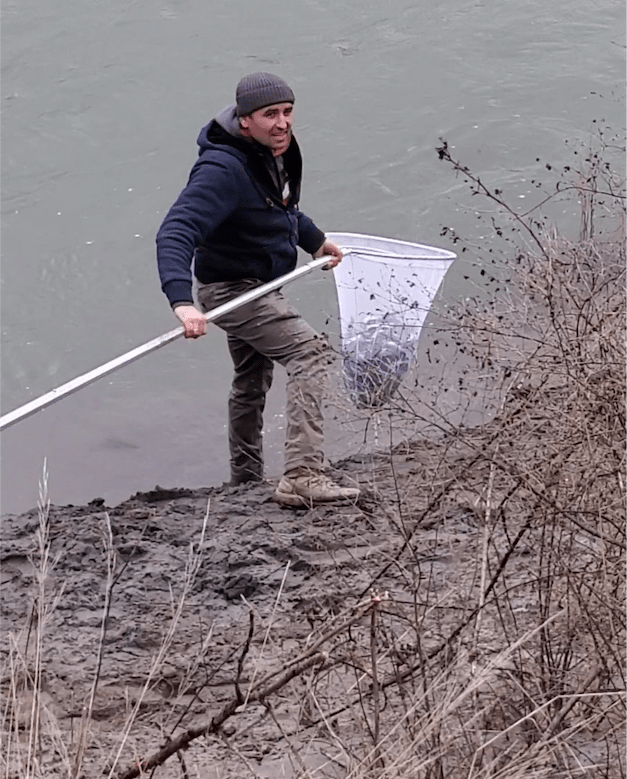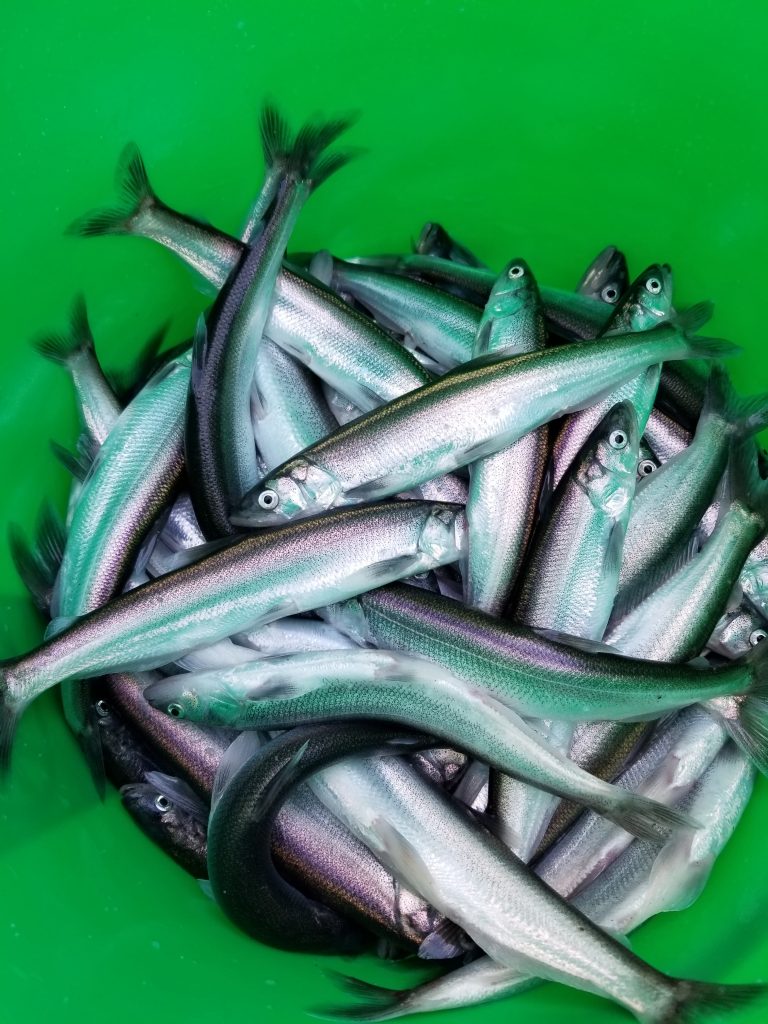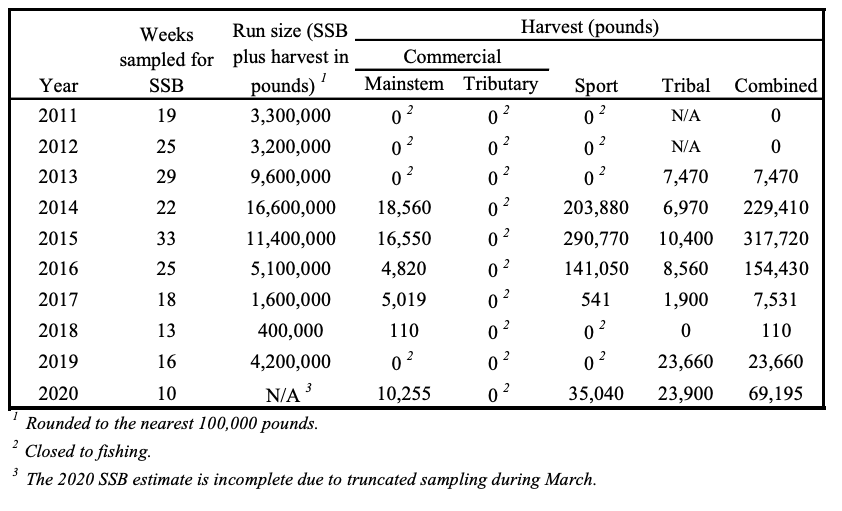Smelt Dippers Averaged 9.2 Pounds – Near Limits – On Cowlitz Opener
Cowlitz dippers hoisted some 45.4 tons of smelt out of the lower river on Tuesday’s five-hour opener, an estimated 90,750 pounds worth that equates to roughly 925,650 individual fish.
The haul is well up from last year, but effort was also higher as around 9,900 people came down to the banks of the Southwest Washington river on a weekday morning to try and harvest their 10-pound limit.

“The average pounds of smelt kept per angler across all areas was 9.2, though upriver sites such as Rocky Point, Lexington and Camelot all averaged around 10 pounds per angler,” reported Laura Heironimus, WDFW Sturgeon, Smelt, Lamprey Unit Lead today.
Earlier this week she said that some fishermen got their entire limit in one scoop of their net.
In February 2020, 4,300 dippers caught 35,040 pounds, about 8.1 pounds on average, with 500 pounds seized for overlimits. This week’s scofflaw tally was about the same.
New this year, WDFW set up riverside sampling stations to collect biological data and talk with the public about the Endangered Species Act-listed fish.
Heironimus said that nearly all of the eulachon brought in for inspection were males, with females comprising just 4 percent of the catch.
“For size, we estimated an average 10.2 fish per pound,” she added.
That means a 10-pound limit would yield 102 smelt for breading and frying, smoking or other uses.
If the gent with the long-handled, fine-meshed net in the checkout line at Outdoor Emporium in Seattle at midday yesterday was any indication, folks are hoping for another go.
Heironimus told outdoor reporter Mark Yuasa that she wasn’t sure if another day of dipping might be held, but managers will be monitoring the results of today’s research-level commercial opener on the mainstem Columbia as one gauge of the run’s progress.

Even so, this opener was a bright spot for WDFW in a week in which the agency also announced tough spring Chinook and steelhead restrictions and closures in response to hatchery and wild fish conservation concerns on Southwest Washington tribs and South and Central Coast rivers, respectively.
It provided a chance to renew a tradition that once boasted 25-pound limits and multiple days a week were open for months.
But as runs declined and seasons tightened up, smelt were listed in 2010 and afterwards dipping was closed for three years.
WDFW was able to get the National Oceanic and Atmospheric Administration’s Fisheries Service to buy into the idea of commercial and recreational “research fisheries” to help fill in data gaps. Heironimus has also pointed out that openers provides a key “connection” for keeping the public engaged in their recovery.
Commercial catches are used to gauge the run as it moves up the Columbia, helping to set sport openers if enough fish are caught.
This January and February’s deliveries weren’t very promising, but then late last month commercial fishermen reported a good surge moving over the bar and up the big river, after which catches jumped from landings averaging in the double digits, pound wise, to 708 and 548 pounds before sliding down to 158 pounds this Monday.
In open years since the early 2010s, recreational fishermen have consistently harvested the largest share, averaging 127,000 pounds over six seasons, some of which also saw openers in Oregon’s Sandy, while tribal ceremonial and subsistence fisheries have averaged 11,850 pounds in the Cowlitz over seven seasons and commercial netters have averaged roughly 9,400 pounds over seven seasons on the Columbia.
A table from the 2021 joint WDFW-ODFW report on smelt outlines catches by year since 2011:

This week’s fishery drew a question on Facebook from a reader who asked if it might affect future runs. Curious about that, I asked Heironimus.
“My projections put the harvest thus far around 1 to 3 percent of the estimated total estimate run size, which is within the target harvest range set by NOAA to ensure a sustainable fishery,” she said.
The preseason forecast was for a “moderate” return – the 2019 run of 4.2 million pounds was described similarly – but Heironimus said that the run size won’t be known till later this year, after biologists evaluate egg and larval smelt numbers.
That’s because even as we may now have seen the big push of smelt for 2021, she notes that smaller schools will continue to make spawning runs over the coming months, and monitoring of those and January’s small surge will go into a reconstruction of the return.
“From the densities of larvae collected throughout the season, we can estimate how many adults had to survive to reproduce, which is considered a conservative measure of abundance. Then we can evaluate the total impact of our harvest compared to those numbers. Overall, I don’t think the 2021 harvest to date is going to have a significant impact on future runs, but hopefully you can see why we had to limit the fishery to such a small amount of time to ensure our overall impact stays low,” Heironimus said.
Last year’s two openers – the second was a bust – were held on a Friday and a Wednesday to limit harvest of the threatened fish.
Their primary population driver – as with many seagoing stocks but even more so in the case of smelt – is, you guessed it, ocean conditions, but runoff through the Cowlitz and Columbia play an early role too.
“As long as we maintain a low impact on the run, what becomes the predominant issue for smelt will be what happens to the larvae on their way out of the river and after they enter the ocean environment,” said Heironimus. “Will the Columbia River plume be strong enough to push them into the ocean in time to begin feeding? Will there be food available once they are out there?”
“Smelt spend 99 percent of their lives in the ocean environment,” she points out. “Shifts in the ocean conditions, such as those caused by El Niño and La Niña, impact the temperatures and food availability for much of our Pacific Northwest anadromous species, which in turn impact growth rates and survival. El Niño events – a warm water phase – have been correlated with poor conditions for ocean salmon survival, and many of these same environmental variables are thought to contribute to Eulachon survival as well.”
“Still so much to study when it comes to Eulachon smelt!”
Indeed. And hopefully this week’s fishery helps to ensure there’s continuing support for the species and one day much more is known.
